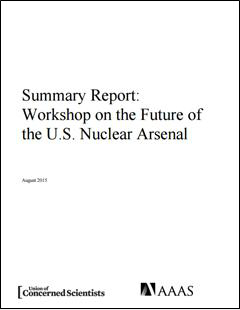Last September UCS, in collaboration with the American Association for the Advancement of Science (AAAS), organized a one-day workshop on the future of the U.S. nuclear arsenal. We are pleased to release the summary report of the conference, which recaps the day and provides key findings.
 About 20 experts participated in the workshop, including active and retired scientists and engineers from Los Alamos, Lawrence Livermore, and Sandia National labs; representatives from the National Nuclear Security Administration (NNSA), Department of Defense (DOD), and the White House Office of Management and Budget (OMB); independent scientists who are members of the JASON group that advises the government on nuclear weapons and other security issues; and representatives from academia and nongovernmental organizations.
About 20 experts participated in the workshop, including active and retired scientists and engineers from Los Alamos, Lawrence Livermore, and Sandia National labs; representatives from the National Nuclear Security Administration (NNSA), Department of Defense (DOD), and the White House Office of Management and Budget (OMB); independent scientists who are members of the JASON group that advises the government on nuclear weapons and other security issues; and representatives from academia and nongovernmental organizations.
To allow for an open discussion, the meeting was held under the Chatham House rule, so the summary report does not identify participants. The discussion covered a range of issues, from the feasibility and desirability of the NNSA’s “3+2” plan for the future of the arsenal, to methods for ensuring confidence in the reliability of stockpile weapons, to modernization of delivery systems. While participants had widely varying opinions about some of these issues, making for a day of lively discussion, the general consensus was that some of the key issues underlying plans for the future arsenal are not well-understood, and further study would be valuable.
Here is a brief summary of the key findings from the day:
- There was broad agreement among participants that more work must be done to assess the financial costs of NNSA’s 3+2 warhead plan and the alternatives.
- There was agreement that using insensitive high explosives in U.S. nuclear weapons would be beneficial, but not on how great a benefit it would convey.
- There was agreement that reducing the hedge would be beneficial, but not on the need for 3+2 to make hedge reductions.
- Currently, there are no other SLBM warheads to serve as a hedge for the W76 warhead; instead, ICBM warheads, bombs and/or ALCMs could be uploaded if the W76 developed a problem. There was no agreement on the value of moving from a force with such inter-leg hedging to one with only intra-leg hedging.
- There was no agreement on either the technical risks or political downsides of designing and producing warheads with components that had not previously been explosively tested together.
- There was disagreement over the likelihood of the failure of one warhead type, as well as whether the technical hedge needs to provide replacement warheads that meet all the targeting criteria of currently deployed warheads.
For more details on all these findings and additional information, please see the summary report.
